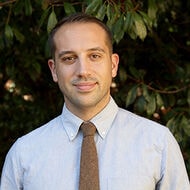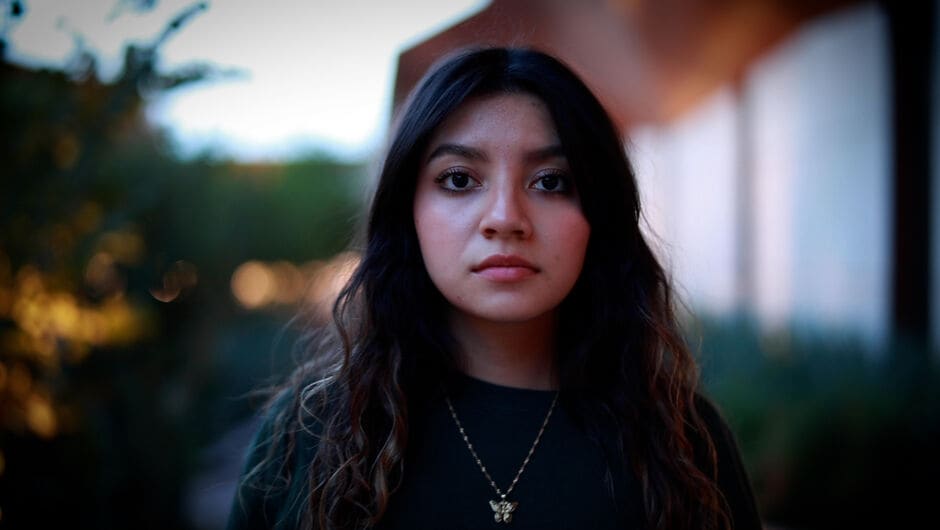When Spirits Dance: Exploring Identity Through Day of the Dead Traditions
Performing arts teacher Christopher Sandoval taps into his students’ cultural identities and family histories by exploring a holiday centered around the dead.
When Spirits Dance: Exploring Identity Through Día de los Muertos Traditions
Performing arts teacher Christopher Sandoval taps into his students’ cultural identities and family histories by exploring a holiday centered around the dead.
January 28, 2022

Video Producer
View transcript
It's never too early to teach anyone about their culture. I really feel like when someone can dance, they can really showcase who they are and what they've been through, and those come out as emotions. They come out as feelings and as energy.
¡Aplausos!
We should let them go. Thank you.
Good morning! I love you everything! ¡Feliz día de los muertos! Hi! Good morning. Buenos dias. Good morning. How are you?
Don’t you love how today is actually Day of the Dead? There’s this whole ‘ambiente’ here. I love it.
So I am painting a flower around your eye. Can you put your hand right here? And pick up your hair? Thank you. Awesome. Do you like it?
Mmm-hmm.
You look so great. So I’m using my face paint to look like a skull or calavera, not to be sad or scared, but to be happy that my grandma is coming back to life today. Her spirit is coming to spend time with me. Can you think of someone?
Mmm-hmm.
Do you know who you could be thinking about? Is there someone in your family that’s not with you no more?
My mom’s dad died.
Your mom’s dad died. Your grandpa?
Yeah.
Christopher: So let’s think about grandpa today. Ok? Ok. Give me foot bump. I’ll see you later. Buh-bye.
Bye.
Have a good day.
My name is Christopher Sandoval. My mother, who was a second-generation Mexican-American, decided to have my twin brother and I, my twin brother and I join a Folklorico class, a Mexican folk recreational class.
When I was younger, I never paid attention to why. But I understand that now. My mother really wanted to make sure that she was in a way fighting for those small opportunities to make sure that culture was preserved in myself and my brother.
Later on, as I really perfected my skills and started to grow for it and build bonds with my teammates. I understood that there was a sense of belonging.
Let’s go!
Let’s go!
Good morning.
Good morning, Mr. Sandoval.
We’re looking for friends who are ready to learn, friends who are ready to celebrate Día de los muertos. Can you say, “día de los muertos?”
Día de los muertos.
November first we celebrate, usually, the spirits of children who have died. Today, November second, we celebrate adults or spirits of adults that have died and are coming back to visit when we make an ofrenda for them. Our ofrenda is an offering to the people we want to honor who are not here no more.
This is George Floyd, and we are going to dedicate our altar to George Floyd. And we are going to always remember that we believe in the words, Black Lives Matter because we know that George Floyd’s life matters. Can I show the next person we are going to dedicate our altar to?
Yes.
OK, look over here. Everybody, can we say Felipe Gomez Alonzo?
Felipe Gomez Alonzo.
Can we say Carlos Hernandez?
Carlos Hernandez.
Can we say Jakelin Maquin?
Jakelin Maquin.
So we want to honor them and other immigrants who crossed and get treated unfairly or unsafely because they want to come for a better life. Everyone look over here on the screen. Our new dance, “La Viejada” is an old dance. It’s been danced for a long time and when we dance this song, we are thinking about the person or the pet that we are honoring in Day of the Dead. Ready? Give me a thumbs up when you know that person. Stand up. The name of our song is called, La Viejada.
1, 2, 3 and clap!
Turn around and clap.
Say, “woo!” Look how strong you are, you get two points for ganas. Remind me.
When I'm teaching dance, I feel like I'm able to give back what people have taught me. I am able to pour into my students what was poured into me.
I’m looking for counters, here we go!
And that was years of confidence, of inclusivity, of traditions, of stories. If we can transmit that through other people, especially our students now during this COVID pandemic, it can really carry them and motivate them and give them momentum to feel that they can believe in themselves.
2,3, 4, good job Jaden, 6, 7, take a bow! Take a bow.
We want our students to understand that there is a really special opportunity during Day of the Dead, to find healing, to find strength in this cultural tradition. When we learn how to, as teachers, find opportunities for our students to value themselves in the curriculum, to value themselves here at school. They're going to be making such a bigger difference and impact on their lives.
Who’s ready to learn? I want to bring the person today to life as I’m dancing, that’s why I wore, I painted a skull, and you’re going to paint one on here. Got it, got it?
Got it, got it.
So when I dance, I bring my grandma to life on Day of the Dead. When you’re dancing with your mask after you’re done, if you’re ready to do it, you’ll bring that person to life too today. And they’ll be with you, in your heart. Got it, got it?
Got it, got it.
We have 30 more seconds to only color our eyes.
My name is Maddie and I'm six years old and I'm in the first grade. I like going to Mr. Sandoval’s class. In class we’re painting a calavera mask.
When I say go you’re going to share with your partner a story about the person or a pet you’re going to honor today. Are we ready? Can everybody tap your calavera and say think, think, think.
Think, think, think.
Well my story is because I did stuff with her because I slept over with my grandma. She, but, she died from cancer.
I’m glad I never had cancer.
Yeah. At first, I thought it was just corona because she died in corona.
Everybody, have a great day. See you tomorrow. Bye.
The dance I’m learning in Mr. Sandoval’s class is “Calaverita”.
In a way it's kind of forcing us as well to kind of touch back with our roots. There's so much to learn from our Mexican culture and for them to lose out on that, and it would be a shame if we didn't pass that on to them.
Look guys, I found more pictures.
Alright, careful, ok. Careful with the flowers.
For day of the dead, my family likes to set up an altar for the ‘ofrenda’. You put their favorite food and their favorite drink. The Day of the Dead is not the same as Halloween. The Day of the Dead is when you celebrate and honor the ones that are not in your family anymore, anymore. And on Halloween, you just get candy.
Why is the candle here?
To light their way, so they know where they’re going.
In the dark.
What are the flowers called? Does anybody know what the flowers are called?
No. Umm, marigolds?
In English. In Spanish?
Cempasúchil.
Cempasúchil?
Doesn’t it sound more cool, the name in Spanish?
Who I’m honoring is my grandma, Nancy. She died from cancer. I’m honoring by dancing for her.
Good.
You feel good! You should feel very proud. Say, “I am proud of me.”
I am proud of me!
I feel very honored and also very, very proud to be able to have the opportunity to pass something forward to allow students to make a decision for themselves that later forges their identity a little stronger at the end of the day.
Someone that I had died from my family is my grandma.
And how are you going to remember your grandma? What can you make for her?
An ‘ofrenda’.
Give him two claps and a whoosh.
Clap, clap, whoosh!
Nice and big!
We are teaching subcultures. We're teaching and opening doors to new experiences. We're here to open minds and we're here to allow for different experiences to happen in our classroom through culturally responsive teaching, so our children could walk out being more successful and more responsible citizens of this country, of their community.
¡Aplausos!
We should let them go. Thank you.
Good morning! I love you everything! ¡Feliz día de los muertos! Hi! Good morning. Buenos dias. Good morning. How are you?
Don’t you love how today is actually Day of the Dead? There’s this whole ‘ambiente’ here. I love it.
So I am painting a flower around your eye. Can you put your hand right here? And pick up your hair? Thank you. Awesome. Do you like it?
Mmm-hmm.
You look so great. So I’m using my face paint to look like a skull or calavera, not to be sad or scared, but to be happy that my grandma is coming back to life today. Her spirit is coming to spend time with me. Can you think of someone?
Mmm-hmm.
Do you know who you could be thinking about? Is there someone in your family that’s not with you no more?
My mom’s dad died.
Your mom’s dad died. Your grandpa?
Yeah.
Christopher: So let’s think about grandpa today. Ok? Ok. Give me foot bump. I’ll see you later. Buh-bye.
Bye.
Have a good day.
My name is Christopher Sandoval. My mother, who was a second-generation Mexican-American, decided to have my twin brother and I, my twin brother and I join a Folklorico class, a Mexican folk recreational class.
When I was younger, I never paid attention to why. But I understand that now. My mother really wanted to make sure that she was in a way fighting for those small opportunities to make sure that culture was preserved in myself and my brother.
Later on, as I really perfected my skills and started to grow for it and build bonds with my teammates. I understood that there was a sense of belonging.
Let’s go!
Let’s go!
Good morning.
Good morning, Mr. Sandoval.
We’re looking for friends who are ready to learn, friends who are ready to celebrate Día de los muertos. Can you say, “día de los muertos?”
Día de los muertos.
November first we celebrate, usually, the spirits of children who have died. Today, November second, we celebrate adults or spirits of adults that have died and are coming back to visit when we make an ofrenda for them. Our ofrenda is an offering to the people we want to honor who are not here no more.
This is George Floyd, and we are going to dedicate our altar to George Floyd. And we are going to always remember that we believe in the words, Black Lives Matter because we know that George Floyd’s life matters. Can I show the next person we are going to dedicate our altar to?
Yes.
OK, look over here. Everybody, can we say Felipe Gomez Alonzo?
Felipe Gomez Alonzo.
Can we say Carlos Hernandez?
Carlos Hernandez.
Can we say Jakelin Maquin?
Jakelin Maquin.
So we want to honor them and other immigrants who crossed and get treated unfairly or unsafely because they want to come for a better life. Everyone look over here on the screen. Our new dance, “La Viejada” is an old dance. It’s been danced for a long time and when we dance this song, we are thinking about the person or the pet that we are honoring in Day of the Dead. Ready? Give me a thumbs up when you know that person. Stand up. The name of our song is called, La Viejada.
1, 2, 3 and clap!
Turn around and clap.
Say, “woo!” Look how strong you are, you get two points for ganas. Remind me.
When I'm teaching dance, I feel like I'm able to give back what people have taught me. I am able to pour into my students what was poured into me.
I’m looking for counters, here we go!
And that was years of confidence, of inclusivity, of traditions, of stories. If we can transmit that through other people, especially our students now during this COVID pandemic, it can really carry them and motivate them and give them momentum to feel that they can believe in themselves.
2,3, 4, good job Jaden, 6, 7, take a bow! Take a bow.
We want our students to understand that there is a really special opportunity during Day of the Dead, to find healing, to find strength in this cultural tradition. When we learn how to, as teachers, find opportunities for our students to value themselves in the curriculum, to value themselves here at school. They're going to be making such a bigger difference and impact on their lives.
Who’s ready to learn? I want to bring the person today to life as I’m dancing, that’s why I wore, I painted a skull, and you’re going to paint one on here. Got it, got it?
Got it, got it.
So when I dance, I bring my grandma to life on Day of the Dead. When you’re dancing with your mask after you’re done, if you’re ready to do it, you’ll bring that person to life too today. And they’ll be with you, in your heart. Got it, got it?
Got it, got it.
We have 30 more seconds to only color our eyes.
My name is Maddie and I'm six years old and I'm in the first grade. I like going to Mr. Sandoval’s class. In class we’re painting a calavera mask.
When I say go you’re going to share with your partner a story about the person or a pet you’re going to honor today. Are we ready? Can everybody tap your calavera and say think, think, think.
Think, think, think.
Well my story is because I did stuff with her because I slept over with my grandma. She, but, she died from cancer.
I’m glad I never had cancer.
Yeah. At first, I thought it was just corona because she died in corona.
Everybody, have a great day. See you tomorrow. Bye.
The dance I’m learning in Mr. Sandoval’s class is “Calaverita”.
In a way it's kind of forcing us as well to kind of touch back with our roots. There's so much to learn from our Mexican culture and for them to lose out on that, and it would be a shame if we didn't pass that on to them.
Look guys, I found more pictures.
Alright, careful, ok. Careful with the flowers.
For day of the dead, my family likes to set up an altar for the ‘ofrenda’. You put their favorite food and their favorite drink. The Day of the Dead is not the same as Halloween. The Day of the Dead is when you celebrate and honor the ones that are not in your family anymore, anymore. And on Halloween, you just get candy.
Why is the candle here?
To light their way, so they know where they’re going.
In the dark.
What are the flowers called? Does anybody know what the flowers are called?
No. Umm, marigolds?
In English. In Spanish?
Cempasúchil.
Cempasúchil?
Doesn’t it sound more cool, the name in Spanish?
Who I’m honoring is my grandma, Nancy. She died from cancer. I’m honoring by dancing for her.
Good.
You feel good! You should feel very proud. Say, “I am proud of me.”
I am proud of me!
I feel very honored and also very, very proud to be able to have the opportunity to pass something forward to allow students to make a decision for themselves that later forges their identity a little stronger at the end of the day.
Someone that I had died from my family is my grandma.
And how are you going to remember your grandma? What can you make for her?
An ‘ofrenda’.
Give him two claps and a whoosh.
Clap, clap, whoosh!
Nice and big!
We are teaching subcultures. We're teaching and opening doors to new experiences. We're here to open minds and we're here to allow for different experiences to happen in our classroom through culturally responsive teaching, so our children could walk out being more successful and more responsible citizens of this country, of their community.









